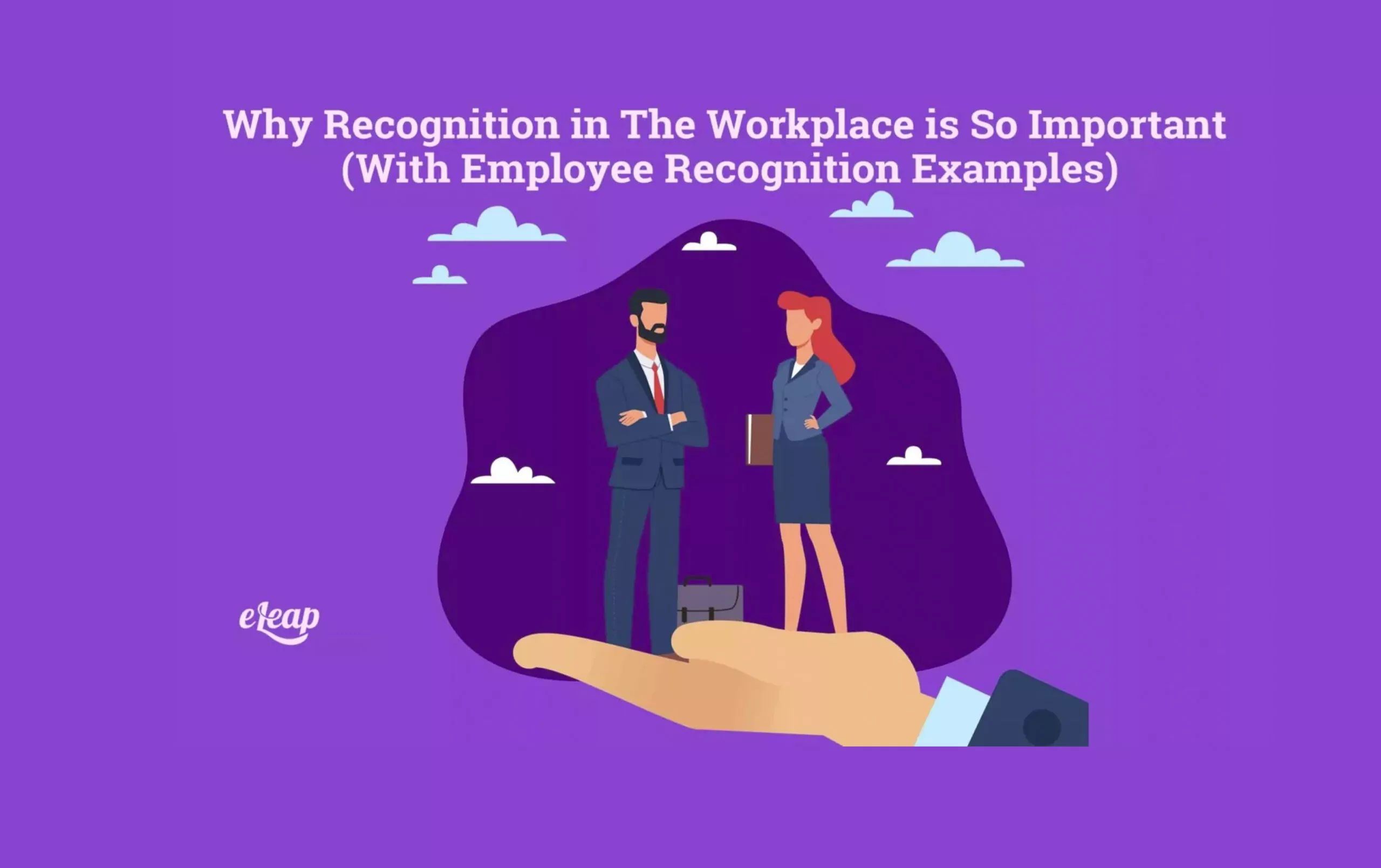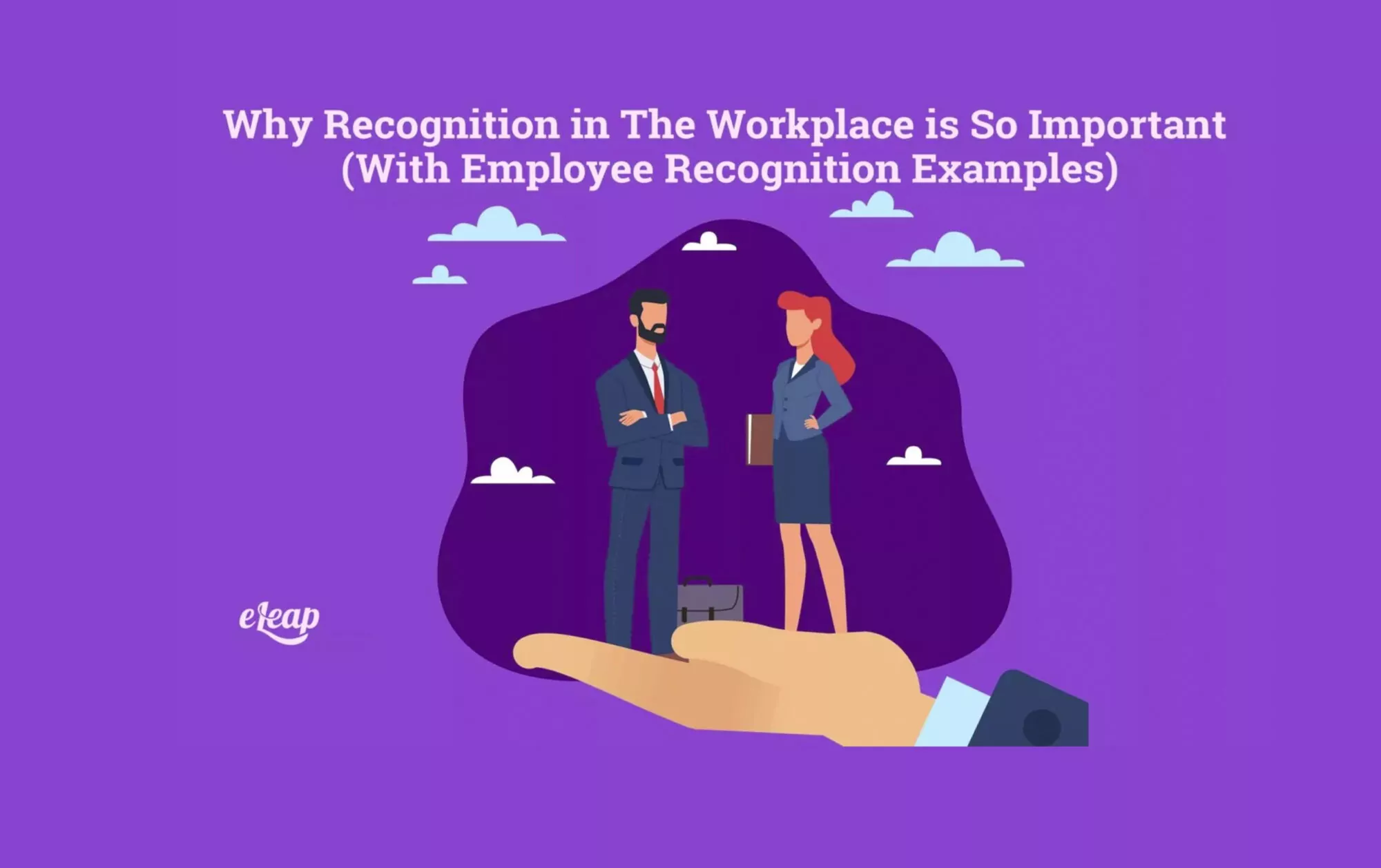Why Recognition in The Workplace is So Important (With Employee Recognition Examples)

Recognition is important for employees to feel heard and valued in their companies, however, there are many strategies to recognize a job well done, which is why we’ll dive into the importance of recognition, and some employee recognition examples, below.
Recognition can help employees enjoy their job more and become more engaged. Different achievements may call for different types of recognition. Turning in a well-written report may constitute a different kind of recognition than closing a multi-million-dollar sales deal for the company. Each achievement calls for meaningful recognition, but it’s up to the employer to create a framework for how employees will be recognized.

Categories of Employee Recognition Examples
Someone who consistently turns in well-researched reports or presentations deserves recognition just as much as the lead engineer who fixes a major bug. However, how, and when recognition is given is important. Too much recognition can cause employees to feel like it is disingenuous. Too little recognition can cause employees to feel undervalued and burnt out.
Essentially, there are three categories of times and moments that recognition should be given:
- Immediate. If any employee turns in stellar work or agrees to take a last-minute sales call to help the team, recognition should be given immediately. For short-term tasks like these, it can be easy to blow over it or think no recognition is needed because “it’s what they should be doing as an employee”, but that’s not true. Any time a manager sees work or characteristics in an employee that they want to continue, they should recognize how much they appreciate what that employee has done. This can be as simple as a job well done or a sincere thank you email.
- Specific. Specific recognition should be given after an employee has put a concerted effort into a project, deal, presentation, etc. Special recognition should be planned for employees who hit major milestones or successfully spearhead a new project, for example. In situations where an employee has achieved something “above and beyond” their daily tasks, specific recognition helps them feel seen and appreciated.
- Regular. In their normal day-to-day, it’s likely your employees do things that help someone else out or create success for the company in some way. This can be as simple as always being on time for meetings or always meeting deadlines for projects. These good behaviors, such as proficient time management and communication skills, should not be overlooked. By giving regular, positive feedback on these traits, employees are more likely to continue what they are doing.
Different Employee Recognition Examples by Category
It can be hard to think up new and meaningful ways to recognize your team members. Using the categories in the previous section (immediate recognition, specific recognition, and regular recognition). We have compiled different ideas for each category of recognition to show your employees that you appreciate their work.
Regular Employee Recognition Examples
As stated, regular recognition is important for keeping employees engaged. Even small wins deserve celebrations, too. When you provide consistent and regular recognition for any employee’s efforts, it makes them feel valued.
Regular recognition does not need to be as grand as more special recognition cases, but it should be something thoughtful.
Here’s some idea to recognize that awesome email your employee wrote or their ability to quickly pull together a report for you:
- Authentic thank you notes. A simple thank you isn’t always enough – be sure to highlight what the employee did for you and why it made you grateful to have them on the team.
- Buy them a coffee or even a coffee gift card. Coffee is a low-price gift that shows appreciation.
- Highlight the employee’s achievement in a public channel. Posting the employee’s contribution on a public channel, such as a company Slack channel or message board, can make the employee feel seen.
Immediate Employee Recognition Examples
If an employee turns around a task on a tight deadline despite everything else they have on their to-do list, it’s important to give immediate and meaningful recognition. This can look like this:
- Promptly respond to the employee’s contribution, whether via email or call, to let them know you see and appreciate their help.
- Give them an immediate reward, such as an electronic gift card, or credit them a few hours off via your HR software. If showing gratitude through gifts is a part of your company culture, technology has allowed us to gift more quickly than ever before.
- Give an immediate thank you, followed by a larger gesture of appreciation. Just because you give immediate feedback, doesn’t mean you can’t circle back to the employee’s contribution once the whole project is complete. Highlighting their part in completing a project during a team meeting or company message can help them feel appreciated and allows them to see what their contribution added to the value of the project overall.
Specific Employee Recognition Examples
If an employee goes above and beyond to complete a difficult project or task, or in some other way achieves something outside of their normal day-to-day. It’s time for a tailored and special thank you.
Some examples of specific employee recognition are:
- Throw a party. This doesn’t need to be anything elaborate. Arrange for a group of colleagues to stay and have drinks after work or go out to a local eatery to celebrate the employee’s achievement.
- Build a structure for special awards. Some companies have awards given every month for one employee who had a particularly outstanding performance or achievement that month. Even better if the employee can receive the reward in front of their colleagues, such as in a team meeting setting. You can even give a trophy or other memento to remind them of their achievement.
- Post a company-wide shoutout. Whether virtual or in-person, highlight the achievement your employee made and what it did for the company overall. Whether it’s in a meeting or online.
- Ask them what they’d like. If you’re looking for an appropriate gift or reward for the employee’s contribution, they would be the first to know what they’d like. It could be as simple as a new item for their desk or a gift card to their favorite eatery.
Employee Recognition Examples by Job Function
Just because someone is in leadership doesn’t mean they don’t deserve a pat on the back for a new achievement. Additionally, a team who has come together to solve a complex issue should be rewarded as a team.
Entire Team Recognition Examples
If an entire team came together to work on a project and succeeded, that is a behavior you’ll want to recognize. Some nice ways to recognize a specific team and/or department’s hard work are:
- Get them a catered lunch. Nobody can say no to free lunch! Plus, it’s a great time for them to relax with colleagues and reflect on their achievements.
- Plan a team outing. If the team wants to leave work a few hours early and do an activity, such as bowling or hiking together, allow them to do so as recognition for a job well done.
- Company-wide recognition. In many organizations, departments do not have a lot of insight into what the other is doing or achieving. That’s why it’s important to recognize a team’s accomplishments on a channel where everyone in the company can see the great work they have done.
Peer-to-Peer Recognition Examples
Although getting noticed by leadership is a great feeling for employees. It’s often even greater for them to be recognized and celebrated by their peers. Usually, employees’ peers are the ones who see them working through the complexities of their assignments. So employees might find it valuable to celebrate alongside their peers who have seen them every step of the way.
Some examples of peer-to-peer recognition are:
- Have colleagues leave cards or sticky notes of appreciation on the person’s desk before they arrive. It will be a great feeling to show up to so many kind words from their peers!
- Create a traveling team trophy. A team trophy can be an object such as a stuffed animal, trophy, or even something sillier like a wand that gets awarded to an individual who achieved a big success each month. This will create bonding among peers.
- Get your colleague their favorite treat. If your colleague loves brownies, maybe bake them a batch as recognition for their hard work. Bonus points if you can put a special message on the treat for them!
Leadership Recognition Examples
Leadership often gets the short end of the stick when it comes to having someone recognize them for achievements. Even so, C-suite executives and subordinates can still congratulate and appreciate their leadership team in meaningful ways.
- Get the team to chip in on something special. Did your manager just achieve a big milestone? Pool money together from the team to buy them a nice bottle of wine or gift card to a favorite restraint. This keeps the monetary commitment small for all members while showing their leader appreciation.
- Show them the team appreciates them with a personalized message. Whether it’s old school on a card, or new school via video or Word document, have each employee write a message of appreciation for their manager that can be shared with them.
- Explore title changes. For C-suite executives who manage leaders, if a leader is particularly successful in their role. It might be time to explore giving them a title that better reflects the contributions they have made. This can come with or without a pay bump. But even a title change with no pay bump shows leaders that their contributions are being noticed and rewarded.
Bottom Line
Employee recognition is so important to show employees you truly care about them and appreciate the contributions they have made. It can change their outlook on their organization and make them happier and more efficient employees. Everyone loves to be recognized for the work they’ve done. Putting a concerted effort into ensuring employees are recognized is an easy. Low-cost way to boost morale and enhance company culture! The eLeaP continuous performance management system provides organizations with powerful options to attract and retain high caliber team members.